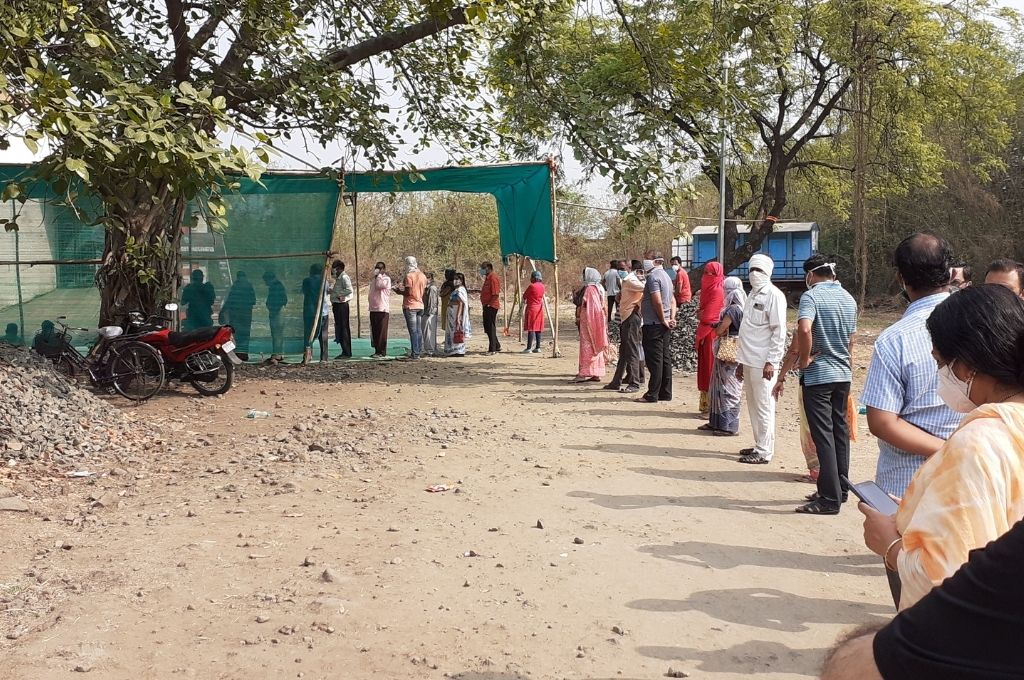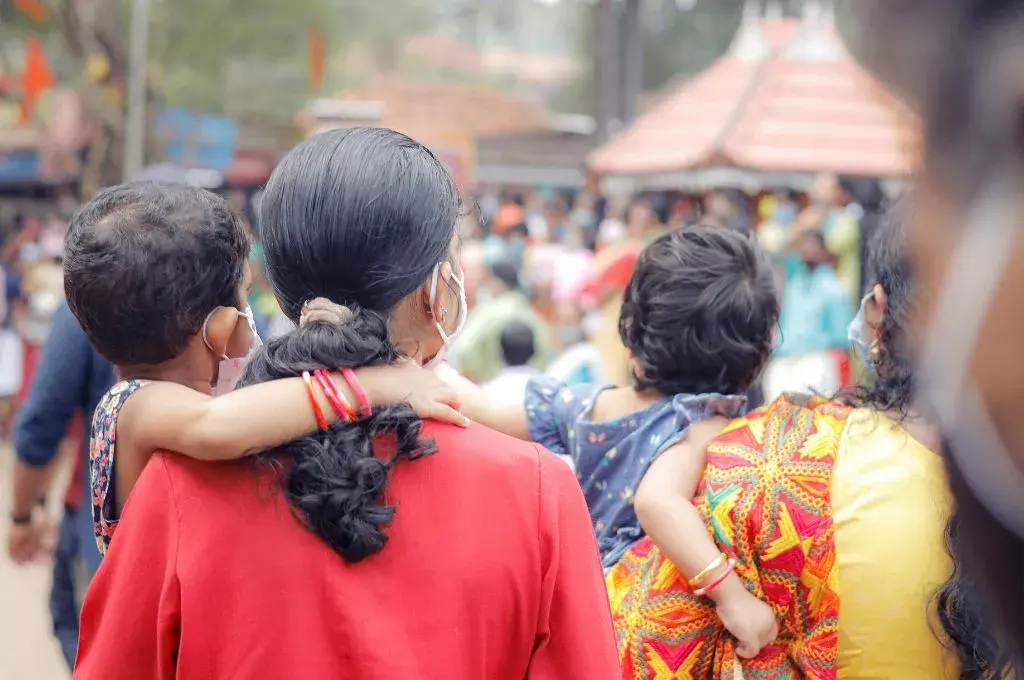The second wave of COVID-19 is rippling through Assam, with April 2021 seeing an exponential rise in cases. On March 31st, 2021 there were 49 cases. A month later, on April 30th, the number of cases had risen 80 times to 3,197. And they continue to increase, with 4,936 cases detected on May 6th.
In terms of total numbers, 27,045 cases were reported in April 2021.1 This is in stark contrast to the number of people who tested positive in January (933), February (396), and March (875).
According to Dr Sunil Kaul, founder of the Ant, a nonprofit that works with communities in Assam, if one extrapolates this curve, we are likely to see cases grow by a factor of 69 times from the current numbers.
As a result, panic has begun to set in, mainly in Guwahati, but also in other towns in the state to an extent. The government has tightened curfew hours in an attempt to restrict mobility. Starting May 5th, shops must shut down at 2 PM and curfew has been extended from 6 PM to 5 AM.
Rural Assam hasn’t yet woken up to the scale of the crisis
This can largely be attributed to the fact that Assam and the other northeastern states missed the pandemic almost entirely during the first wave. Assam reported 2,18,470 cases between April 2020 to March 2021. Most of these were in Guwahati, in the Kamrup Metropolitan district.
Beyond Guwahati, it was business as usual despite a national lockdown. In Chirang, a district in northern Assam where The Ant is headquartered, there were almost no cases at all. Clinics, local businesses, and shops opened in early May 2020; Guwahati opened up in August 2020.
While the virus is yet to make its presence felt in rural Assam, the fear is that if it does, the state’s infrastructure is wholly inadequate.
In the first wave, with the nationwide lockdown and migrants returning home to no jobs, the initial need among the people in Assam was for food and rations. To this end, the Assam government provided INR 2,000 as monetary assistance to approximately 3.5 lakh people stranded outside the state under its Assam Cares programme.
On the ground, organisations such as The Ant addressed this issue of no income and the need for food rations by distributing cash to vulnerable families. The reason was twofold: to prevent an inflow of infection from cities and kickstart local village economies.
Between April and June 2020, relief was mainly distributed in the form of food packets, wrapped in plastic. In addition to running the risk of the food packets being handled by people en route to the villages in Assam, the packets were also generating large amounts of plastic waste. Most districts outside Guwahati are non-monetised and function as cash-based economies. With bank ATMs located 30-40 kilometres away from villages, access to cash was a challenge. Therefore, receiving cash instead of rations helped people access necessities within their villages and blocks and also helped boost local businesses.
The second wave is making its impact felt, but largely in the bigger towns
In the last month, the number of people who have tested positive for COVID-19 has increased dramatically, as has the number of deaths. This seems to be driven by multiple reasons. One of the most well-known reasons is the election rallies held ahead of the State Assembly election, which took place in three phases between March 27th and April 6th, 2021.
On April 9th, 25,119 COVID-19 tests were conducted and 281 positive cases were detected. Three weeks later, testing increased three-fold, but the number of cases had increased more than 11-fold to 3,197 cases on April 30th.
As of May 6th, the case positivity rate has jumped to 8.04 percent with 4,936 new cases being reported.
“Despite the increasing number of cases, people still aren’t realising the seriousness of the issue because they are still caught up in the euphoria of the election results,” says Hasina Kharbhih, Founder, Impulse NGO Network, a collective of more than 40 nonprofits working in the eight states of the Northeast.
She also attributes the rise in cases to the very public celebrations of Bihu (the Assamese new year), with groups of people congregating—with no masks and no social distancing—to celebrate the state’s most important festival.
Moreover, inter-state trains and buses that have been running regularly have been bringing people back from various parts of the country. Though the numbers of returning migrants is far smaller when compared to the first wave, some of them are likely carrying the infection home as they leave states that have moved into lockdown mode.
According to Gautam Baruah, Chief Operations Architect, Balipara Foundation, which works across villages in North and East Assam, the impact of the second wave is largely being felt in urban Assam. “The villages still seem cut off from the impact of the pandemic and we still haven’t seen any significant cases in rural areas, largely because of their healthy lifestyle. The situation seems to be worsening in the towns mainly,” he said.
What’s happening on the ground?
Testing
In the first week of January 2021, the government conducted 94,533 tests in all, or an average of 13,500 tests every day. The case positivity rate was 0.46 percent. As of May 6th, with more than 60,000 tests being conducted daily, the case positivity rate has jumped to 8.04 percent with 4,936 new cases being reported.
Health officials in Assam have said that if the number of tests is increased from the current levels of about 60,000 tests per day to 1 lakh, the state will see these numbers go up further.
The challenge, however, will be to increase testing across districts. As with other states, frontline health workers—ASHAs and ANMs—have been deployed to help with the crisis. However, unlike other states, ASHAs in Assam have not been trained to conduct RT-PCR tests; their job is limited to collecting samples for these tests and conducting rapid antigen tests.
Even as attempts are being made to increase testing, according to Dr Kaul, after a certain point the number is likely plateau for three reasons:
- There isn’t enough infrastructure—labs, technicians, and doctors—that can test for more than a particular number of people every day, not in Guwahati and definitely not in other districts in the state.
- In the larger towns, because of possible crowding at the test centres, people will hesitate to go for testing out of the fear that they will catch the infection at those centres.
- If one person in the family tests positive, the rest of the family assumes that they have the virus when they display similar symptoms and do not bother to get themselves tested.
Vaccination
There were 3.37 lakh vaccines available in Assam as of May 4th, 2021. With around 80,000-90,000 vaccinations being done daily, vaccine stocks are likely to run out soon. As of May 5th, 6.88 percent of the population had received the first dose and approximately 1.9 percent had received both doses.2 Most of these doses have been administered in Guwahati.

In rural areas, people are indifferent about vaccination because many believe that the second wave of COVID-19 has bypassed Assam just like the first wave did. However, despite this apathy, ASHA workers are encouraging people to get vaccinated.
According to Baruah, “The situation seems more or less in control for the moment here. People who show symptoms can get themselves tested at the local health subcentres. ASHAs are also encouraging people to get themselves vaccinated. It’s easier to get vaccinated in the villages than in Guwahati,” he added.
What if it gets worse?
While the virus is yet to make its presence felt in rural Assam, the fear is that if it does, like the rest of rural India, the state’s infrastructure is wholly inadequate.
“We are already beginning to see beds in civil hospitals and district hospitals fill up. If cases increase in the smaller towns, there aren’t enough facilities to manage the load. While the health subcentres can do basic testing and vaccination, they aren’t equipped to deal with severe cases. If people start requiring oxygen, there is going to be a real problem,” says Baruah.
According to Dr Kaul, even if oxygen cylinders are made available, these will be of limited use in the district hospitals, because while they have ventilators, most of them do not have a piped oxygen setup which is needed for these ventilators to function.
—
Footnotes:
- This figure has been calculated by adding up the ‘New cases detected today’, for all days in April 2021, as reported by the National Health Mission, Assam.
- This figure has been calculated by dividing the cumulative state-wide vaccination data (reported by the Ministry of Health and Family Welfare) by the total population of Assam (as per the 2011 Census).
—
Know more
- Read more about how Bihar has been responding to the COVID-19 second wave.
- Read about the unique challenges of and suggestions to respond to COVID-19 in rural India.
Do more
- Support nonprofits working towards COVID-19 relief efforts in Assam—CHILDLINE India Foundation, Child In Need Institute (CINI), Habitat for Humanity India, Haqdarshak Empowerment Solutions Private Limited, iPartner India, Purva Bharati Educational Trust, TYCIA Foundation, and United Way Mumbai.





